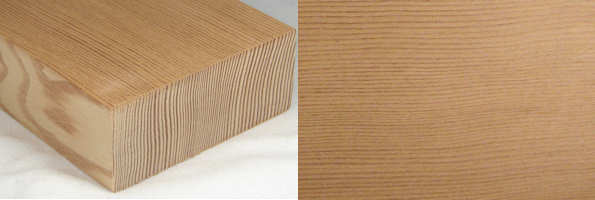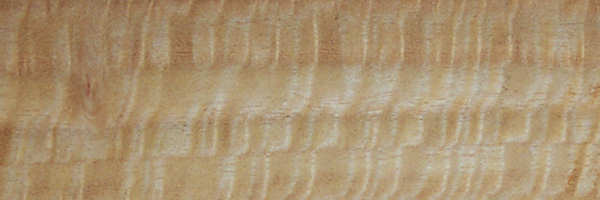"THE LOOK OF PROCESSED WOOD"
There are numerous characteristics that go into creating the look of wood, both as it grows in, and then as it is cut from, a tree.
Listed below are the major types of LOOK that result from various combinations of these characteristics.
Each image is clickable and takes you to a more extensive definition.
cuts (the way wood is processed)

flat cut --- cut parallel to the trunk and away from the pith

quartersawn --- the pith of the log is in the plane of the cut

rift cut --- part way between flat cut and quartersawn (mostly used on oaks)

rotary cut --- swirly figure in veneer (NOT planks) caused by rotary cutting
(a rotating cut around the circumference of a log)

cathedral grain --- flat cut in a way that creates an arched pattern (also called crown cut)

crotch --- the area where two trunks or a trunk and branch join
stains (various types)

blue stain --- fungus in sapwood
[no image available]
brown stain --- two types, one fungal, one due to kiln drying
[no image available]
chemical stain --- due to concentration and modification of extractives
[no image available]
gray stain --- an oxidization process

mineral stain --- minerals from the soil carried up in the sap

metal stain --- due to moisture plus contact with ferrous metal

white rot --- a particular form of fungal attack that leaves a white stain

water stain --- due to water
GRAIN (various types)

interlocked grain --- grain changes directions over growing seasons

irregular grain --- grain varies significantly from the normal straight grain

straight grain --- simple straight grain up and down the tree

wavy grain --- wood fibers run in a wavy pattern
wood tissue structure characteristics
extensive illustrated discussions in wood anatomy

growth rings --- the annual growth rings with earlywood / latewood

growth ring porosity (ring porous, semi ring porous, diffuse porous)

growth ring pore distribution (radial strands, dendritic groups, wavy bands, etc)

various types of parenchyma

rays --- strips of cells that radiate horizontally inside the trunk of a tree

tyloses ---- crystal-looking tissue that fills up the pores in some woods (white oak, black locust, butternut, etc.)

heartwood/sapwood demarcation --- sharpness of the line (or area) between the two
ranges from very sharp to very vague
FIGURE (various types)

ambrosia --- heavy streaking caused by the ambrosia fungus, as introduced into the wood by various species of beetle

angel step --- staircase figure that occurs in some cuts of tree stumps

bear claw / bear scratch --- looks like the wood was scratched by a bear (mostly occurs in maple and sitka spruce)

bird's eye --- lots of little "eye" spots

blister --- lots of little "blisters"

burl --- usually wild and swirly and/or with lots of eyes and localized clumping of cell groups

cat's paw --- a type of cluster burl, rather obviously named

clear --- having no knots or flaws

cluster burl --- an isolated grouping of burl figure

curly --- looks like rumpled cloth
NOTE: with some woods, maple in particular, the term "tiger" means the same thing

feather crotch --- a particular form of crotch figure (also called flame crotch)

fiddleback --- an intense cross-grain curl

flaky --- shows heavy ray flakes

flame --- has three unrelated meanings, depending on the wood
(1) box elder "flame" means it has the red streaks
(2) birch, maple, and some other, "flame" is synonymous with "curly"
(3) walnut, mahogany, and some others, "flame" is used to describe certain patterns in crotches

graft line --- occurs in grafted trees

knotty --- contains multiple knots

masur --- a particular, odd, grain type that occurs in birch
mottle
(there are various forms of mottle, including several which are illustrated below)

basket weave --- a type of block mottle that looks like the side of a basket

bee's wing --- looks like tight razor mottle that has been broken up (literally, looks like a bee's wing)

block mottle --- mottled with a fairly regular arrangement

mottled --- mottled with a somewhat irregular arrangement (also called broken mottle)

razor mottle --- fairly long, regular, very sharp mottles
end mottle
FIGURE (continued)

peanut shell --- looks like peanut shells

pecky --- elongated cavities cause by fungal attack and decay

pippy --- looks like the wood has the measles

pomelle --- like a puddle being hit by raindrops

quilted --- looks like lots of air bubbles in water under glass

roey --- same as striped (roey literally means "having rows") but not ribbon striped

ribbon stripe --- looks like parallel ribbons running lengthwise (with the grain)

sausage quilt --- quilted with somewhat elongated, parallel, "quilts" that look like tube sausage

spalted --- figure caused by spalting (a fungal attack in dead sapwood)

special --- a term applied to a particular form of figure in etimoe

swirl --- swirly figure caused by near-crotch, rotary cutting, etc.
tiger --- a term that is sometimes used with some woods, maple in particuar, as synonymous with curly

waterfall --- vague term, mostly used with two different kinds of bubinga, one quilted and the other rotary cut

wild --- vague term for extreme figure

wormy --- figure dominated by worm etchings or worm holes